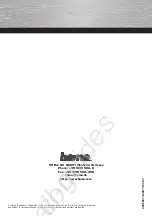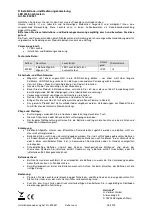
G
Installation and Commissioning
Devices are to be connected under deadvoltage condition. Devices must
only be connected to safety extralow voltage. Consequential damages
caused by a fault in this device are excluded from warranty or liability.
These devices must be installed and commissioned by authorised
specialists. The technical data and connecting conditions shown on the
device labels and in the mounting and operating instructions delivered
together with the device are exclusively valid. Deviations from the
catalogue representation are not explicitly mentioned and are possible
in terms of technical progress and continuous improvement of our
pro ducts. In case of any modifications made by the user, all warranty
claims are forfeited. Operating this device close to other devices that
do not comply with EMC directives may influence functionality. This
device must not be used for monitoring applications, which serve the
purpose of protecting persons against hazards or injury, or as an
EMERGENCY STOP switch for systems or machinery, or for any other
similar safetyrelevant purposes.
Dimensions of housing or housing accessories may show slight toler
ances on the specifications provided in these instructions.
Modifications of these records are not permitted.
In case of a complaint, only complete devices returned in original packing
will be accepted.
Our “General Terms and Conditions for Business“ together with the
“General Conditions for the Supply of Products and Services of the
Electrical and Electronics Industry“ (ZVEI conditions) including
supplementary clause “Extended Retention of Title“ apply as the
exclusive terms and conditions“.
Notes regarding mechanical mounting and attachment:
Mounting shall take place while observing all relevant regulations and
standards applicable for the place of measurement (e.g. such as welding
instructions, etc.). Particularly the following shall be regarded:
– VDE ⁄ VDI directive technical temperature measurements,
measurement set up for temperature measurements.
– The EMC directives must be adhered to.
– It is imperative to avoid parallel laying of currentcarrying lines.
– We recommend to use shielded cables with
the shielding being attached at one side to the DDC ⁄ PLC.
Before mounting, make sure that the existing thermometer‘s technical
parameters comply with the actual conditions at the place of utilization,
in particular in respect of:
– Measuring range
– Permissible maximum pressure, flow velocity
– Installation length, tube dimensions
– Oscillations, vibrations, shocks are to be avoided (< 0.5 g)
Attention! In any case, please observe the mechanical and thermal
load limits of protective tubes according to DIN 43763 respectively
according to specific S+S standards!
Notes on commissioning:
This device was calibrated, adjusted and tested under standardised
conditions. When operating under deviating conditions, we recommend
performing an initial manual adjustment onsite during commissioning
and subsequently at regular intervals.
Commissioning is mandatory and may only be performed by qualified
personnel!
G
Resistance characteristics of passive temperature sensors (see last page)
In order to avoid damages ⁄ errors, preferably shielded cables are to be used.
Laying measuring cables parallel with current-carrying cables must in any case be avoided. EMC directives shall be observed!
These instruments must be installed by authorised specialists only!
ATTENTION, NOTE ! Testing current influences the thermometer‘s
measuring accuracy due to intrinsic heating and therefore, should
never be greater than as specified below:
Sensor current, maximum
I
max
Pt1000 (thin-layer) .............................................................................. < 0.6 mA
Pt100 (thin-layer) .............................................................................. < 1.0 mA
Ni1000 (DIN), Ni1000 TK5000 ....................................................... < 0.3 mA
NTC xx ...................................................................................................... < 2 mW
LM235Z ....................................................................................... 400 µ A … 5 mA
KTY 81 - 210 .............................................................................................. < 2 mA
Limiting deviation according to classes:
Tolerances at 0 °C:
Platinum sensors (Pt100, Pt1000):
DIN EN 60751, class B ........................................................................ ± 0.3 K
1 ⁄ 3 DIN EN 60751, class B .................................................................± 0.1 K
Nickel sensors:
NI1000 DIN EN 43760, class B .............................................................. ± 0.4 K
NI1000 1 ⁄ 2 DIN EN 43760, class B ..................................................... ± 0.2 K
NI1000 TK5000 ................................................................................... ± 0.4 K


































